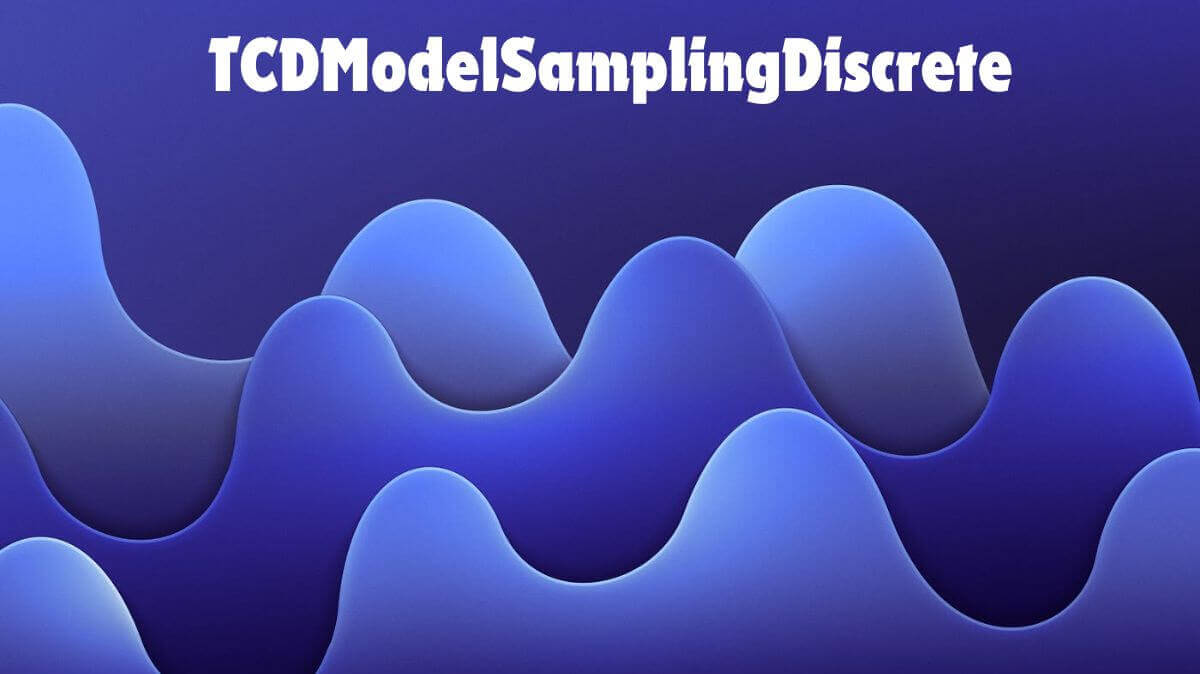Have you ever wondered how complex models handle discrete data? Enter TCDModelSamplingDiscrete—a powerful tool that’s making waves in the world of data science. This innovative approach offers a unique way to sample discrete distributions, unlocking new possibilities for researchers and analysts alike. Whether you’re knee-deep in statistics or just curious about modern methodologies, understanding TCDModelSamplingDiscrete could be your next big leap into the realm of advanced analytics. Let’s dive deeper and explore what makes this model stand out!
What is TCDModelSamplingDiscrete?
TCDModelSamplingDiscrete is a specialized statistical model designed for sampling from discrete distributions. It efficiently generates samples that accurately reflect the underlying structure of data.
At its core, TCDModelSamplingDiscrete tackles challenges inherent in modeling scenarios where outcomes are distinct and finite. This includes situations like categorical data analysis or decision-making processes with clear options.
What sets this model apart is its ability to account for various probability distributions while maintaining computational efficiency. Leveraging advanced algorithms, it streamlines the sampling process, making it both robust and user-friendly.
Data scientists can harness TCDModelSamplingDiscrete to enhance predictive accuracy across numerous applications. Its versatility makes it an attractive choice for anyone dealing with discrete datasets—be it in marketing research, finance, or social sciences.
How does TCDModelSamplingDiscrete work?
TCDModelSamplingDiscrete operates through a systematic approach to probability distributions. It takes discrete data points and employs algorithms that facilitate sampling from these predefined distributions.
The process begins by identifying the underlying structure of the dataset. This includes recognizing patterns and correlations within the data. Once established, it uses statistical techniques to generate samples that reflect this structure.
Next, TCDModelSamplingDiscrete iteratively refines these samples. Each iteration enhances accuracy, ensuring results closely mirror real-world scenarios or predicted outcomes.
This method is particularly effective in fields such as machine learning and data analysis where precise representations are crucial for decision-making processes. By focusing on discrete variables, it allows for targeted sampling that other broader models may overlook or misrepresent.
Its design fosters an efficient means of handling complex datasets while maintaining clarity in interpretation.
Advantages of using TCDModelSamplingDiscrete
The advantages of using TCDModelSamplingDiscrete are numerous and impactful. First, it offers enhanced efficiency in data processing. By sampling discrete values, the model reduces computational load while maintaining accuracy.
Another significant benefit is its versatility. It can be applied across various industries, from finance to engineering. This adaptability allows organizations to leverage TCDModelSamplingDiscrete for diverse applications.
Moreover, this method minimizes bias in data interpretation. By focusing on distinct outcomes rather than continuous variables, it promotes more reliable insights.
TCDModelSamplingDiscrete also facilitates better decision-making by simplifying complex data sets. Stakeholders can quickly grasp trends and patterns without wading through excessive information.
Implementing this model encourages innovative approaches to problem-solving. Its unique sampling technique inspires new strategies and solutions that may not have been considered otherwise.
Also Read: Crissybcummin: The Ultimate Guide to Beauty and Lifestyle Essentials
Examples of TCDModelSamplingDiscrete in action
TCDModelSamplingDiscrete finds its application across various fields. In finance, it’s used for risk assessment by simulating different market scenarios. This helps analysts understand potential outcomes and make informed decisions.
In healthcare, researchers utilize this model to predict patient outcomes based on discrete treatment options. By analyzing past data, they can better tailor treatments for individuals.
The gaming industry also benefits from TCDModelSamplingDiscrete. Game developers use it to create unpredictable yet structured environments that enhance player experience.
Additionally, in logistics, companies apply the model to optimize route planning by evaluating numerous delivery scenarios. This not only saves time but also reduces operational costs.
These examples showcase the versatility of TCDModelSamplingDiscrete in real-world applications, demonstrating its ability to improve decision-making processes across diverse industries.
Limitations and challenges of TCDModelSamplingDiscrete
TCDModelSamplingDiscrete, while powerful, comes with its own set of challenges. One significant limitation is the complexity of implementation. Users may need advanced knowledge to navigate its intricacies effectively.
Another challenge lies in scalability. As datasets grow larger, processing times can increase exponentially, leading to inefficiencies. This can be particularly problematic in real-time applications where speed is crucial.
Moreover, TCDModelSamplingDiscrete might struggle with certain types of data distributions. If the underlying assumptions do not align well with the data characteristics, results could be misleading or inaccurate.
There’s often a steep learning curve associated with mastering this model. Beginners may find it daunting without sufficient resources or guidance at their disposal.
Future developments and potential applications
The future of TCDModelSamplingDiscrete looks promising, with ongoing research focusing on refining its algorithms. Enhanced computational power could lead to more sophisticated models that handle larger datasets effectively.
Potential applications span across various industries. For instance, in healthcare, it can improve patient outcome predictions by analyzing discrete data from clinical trials.
In finance, risk assessment models leveraging TCDModelSamplingDiscrete can become more robust, providing clearer insights into market behaviors and trends.
Additionally, the technology might find a place in machine learning frameworks, aiding in better decision-making processes through accurate sampling methods.
As innovation continues, we may even see integration with artificial intelligence tools for real-time analysis and predictions across sectors like retail and manufacturing. The versatility of this model holds immense potential for transforming how data is interpreted and utilized.
Conclusion
The TCDModelSamplingDiscrete offers a fascinating approach to discrete sampling in various fields. Its ability to efficiently handle complex data makes it an invaluable tool for researchers and practitioners alike. By understanding how this model works, the advantages it provides, and its practical applications, users can harness its full potential.
While there are limitations to consider, ongoing developments promise improvements that will enhance its functionality even further. As technology evolves, so too do the possibilities for TCDModelSamplingDiscrete across diverse sectors. Embracing these advancements could lead to innovative solutions that were previously thought unattainable.
As we look ahead, it’s clear that TCDModelSamplingDiscrete holds significant promise for advancing our understanding of data sampling techniques in discrete contexts. The future is bright for those willing to explore what this model has to offer.
